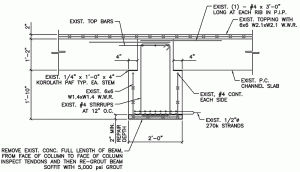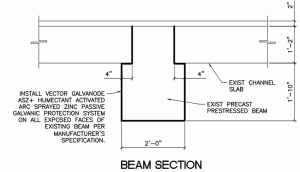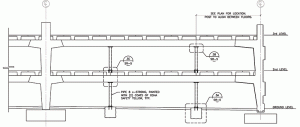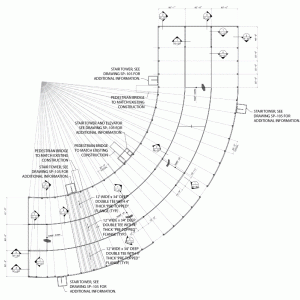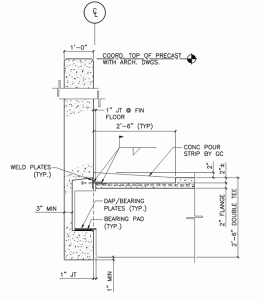The Triage, Life Support and Subsequent Euthanasia of an Existing Precast Parking Garage
As a part of Pennoni Associates’s on-call contract with an existing client, the Philadelphia structural division investigated and developed repair bid documents for an existing, three-level, 1,200-space precast concrete parking garage during the last quarter of 2012. Part 1 of this series (September 2013) described the existing structure and summarized observations and material testing results. Part 2 (November 2013) presented an analysis of those findings. Part 3 (January 2014) conveyed conclusions regarding the feasibility of repairing the garage in order to extend its service life. This article discusses the solution of temporarily stabilizing and ultimately replacing the garage.
Given the limited remaining service-life, extent of damage to the girders, and lack of adequate and cost-effective long-term repair options, replacing the existing garage with a new parking facility on the same site was recommended. While this assessment was based on a “worst-case” scenario, it was strongly believed that the material testing evidence and observed deterioration warranted such significant action.
Temporary Repairs
In order to accommodate the time required for the funding, design and construction of a new garage to replace the current facility, the existing garage required some repairs so that it could remain in service. Therefore, the following measures were recommended in order to extend the life of the structure another ten years:
- Remove approximately two inches of existing concrete at the underside soffit of all level-three cast-in-place, post-tensioned girders and precast, prestressed girders, and approximately 25% of the level-two precast, prestressed girders, for the full length of the beams in order to inspect the condition of the tendons and mild reinforcing. If no further repairs were required, replace the removed concrete with high-strength grout, otherwise repair the girder reinforcing as required (Figure 1). These repairs would restore full use of the third level for parking, albeit with limited service life, and were needed to provide an adequate substrate for item #2 below.
- Install a passive galvanic protection system, such as Galvanode ASZ+ manufactured by Vector Corrosion Technologies, by coating the sides and bottoms of all cast-in-place, post-tensioned and precast, prestressed girders with the repair product (Figure 2). A detailed discussion of the protection mechanism and installation of this type of product is available in the manufacturer’s literature. The passive galvanic system should limit the amount of future deterioration of the girders for an additional five years based on the recommendations of the manufacturer.
- Due to the lengthy anticipated funding, design and construction timeline for a new garage – beyond the extended five-year service life provided by the passive galvanic system – it was also recommended the concrete girders be shored (Figure 3). The purpose of the proposed shoring posts, located at third points of all of the girders in the garage, was to reduce the stresses imposed on the beams due to transient loads, such as those from cars and snow. However, installation of the shoring would not reduce the existing residual dead load stresses, because it was impractical to jack the beams up at each shoring location in order to relieve the existing dead load.
Implementing the shoring scenario reduces the imposed stresses on the beams by 25%, such that only 75% of the existing reinforcement needed to be available to resist the super-imposed loads. Therefore, it would be reasonable to allow for a 25% reduction in the amount of required reinforcement, due to corrosion, before the beams are considered to have reached the end of their practical service life.
Using the worst-case deteriorated beams as the basis for analysis and a maximum existing loss of reinforcement of no more than 10% – one completely deteriorated strand out of a group of ten – results in a maximum anticipated remaining service-life of ten years. Based on the beams in the best condition – i.e., girders that did not currently exhibit any visually detectable deterioration – a remaining service-life of thirteen years may be expected. These calculations were based on the installation of items #1 and #2 above, as well as the shoring posts. An assumed corrosion rate of 100 µm/year (0.00394 inches/year) for carbon steel exposed to atmospheric conditions served as the basis for this increased service-life analysis.
Although the remaining service-life calculations were conservative, it would be reasonable to expect the following scenario for the parking garage structure after the installation of the recommended repairs, galvanic protection system, and shoring:
- 0 to 10 years: Ongoing maintenance program required to clean up isolated spall debris and repair isolated areas identified by annual engineering visual condition assessment.
- 10 to 15 years: Isolated areas of the third, second and ground floors are progressively closed off as areas become unsafe to use.
- 15+ years: Garage is condemned and considered unsafe to occupy .
The shores would be located approximately 20 feet away from the supporting columns, and align with the end of the parking stall striping. In this way, the shoring posts would not affect the driving aisles; however, some parking spaces would be lost because the beam locations did not always align with the parking space striping modules.
Because the intent of these recommendations was only to extend the service-life of the garage as much as was necessary to build a new replacement garage, limited non-intrusive repairs would also be required at prioritized locations in order to address only the most severe observed deficiencies. These included:
- Repairing major cracks in double tees, columns and stair/bridge components by routing and filling with an appropriate epoxy injection system to prevent moisture from entering the concrete.
- Repairing major spalls in double tees, columns and stair/bridge components by saw-cutting around the perimeter of the identified spall or subsurface delamination, demolishing the existing deteriorated concrete within the saw-cut area down to sound material, cleaning and inspecting for cross-sectional loss at embedded reinforcing, and strengthening to replace any significant loss as required. Installing embedded, sacrificial, passive galvanic devices such as Galvashield XP, manufactured by Vector Corrosion Technologies; then patching and finishing the repair area using high-strength cementitious repair materials.
- Perform yearly inspections of the garage for significant deterioration until the new garage is constructed.
It should be noted that the recommended repair scheme was based on the only practical available options that would allow for an extension of the remaining service-life of the garage. Permanently shoring a structure is not an ideal solution and is therefore generally not preferred; however, in the case of this garage, it was necessary to maximize the remaining service life in order to provide enough time to construct a replacement garage. A new garage will be required because at the end of the remaining ten years of service-life, additional repairs will not be economical or feasible, and the lack of a parking garage would severely disrupt facility operations. Therefore, it was imperative that a new parking garage be constructed and ready for use no later than 2022.
It is anticipated that the time required to complete the recommended repairs, including installation of the passive galvanic system and shoring posts, would be approximately 12 months. This is due to phasing the repair work in order to keep as much of the garage operational as possible. The estimated cost is $2.7 million.
Replacement Garage
As part of the project, conceptual structural and parking arrangement drawings for a proposed new five-story, 2,050-space garage were developed (Figure 4). In addition to assisting with the determination of the estimated construction cost of about $54 million, these plans were to demonstrate the construction of a new garage was feasible at the proposed site location, which coincided with the location of the existing garage.
Although the existing garage was framed using double tees of varying lengths that spanned parallel to the driving aisles, and consequently over a shorter distance than the girders, the proposed new garage was conventionally designed to allow for the double tees to clear span across the driving aisle and parking spaces. This would allow all of the double tees to be fabricated to the same length, with tapered flange edges similar to a pie piece. A more conventional approach to framing the garage avoided the end bearing problems that exist in the original structure. It also allowed the girders to span a much shorter distance and, in most cases, allowed the perimeter spandrels to function more efficiently as load-bearing members, rather than just panels (Figure 5).
The construction of the new garage was proposed to be accomplished in two phases. In the first phase, approximately 60% of the existing garage would be demolished, including foundations, and replaced to minimize the impact of the loss of parking on the facility. Additional temporary external ramps would be required to maintain access to all levels of the remaining garage during this first phase. In the second phase, the remaining garage and temporary ramps would be demolished and the balance of the new five-story garage would be constructed, while the first phase of the completed garage would become operational. Since the majority of the new garage would be completed as a part of the first phase, including the internal access ramps, there would be no need for temporary ramps during the second phase.
The size of the conceptual garage was determined based on previously completed feasibility studies that indicated a demand of 2,003 parking spaces for the current operations at the existing facility. Constructing the replacement garage in the same area and in a similar configuration as the existing garage made sense since the existing garage was ideally located to minimize walking distances to the adjacent building. In addition, there were limited areas elsewhere on the campus where a new large garage could be practically constructed.
Although additional planning and design would be required to determine the actual size and location of the proposed and recommended new replacement garage, the final design of the garage was outside the scope of the initial effort. However, Pennoni was confident that the conceptual drawings were feasible, cost-effective, and an excellent starting point for the planning, design and funding of an actual replacement garage.▪

